Library Management System Project: Design and Implementation Details
VerifiedAdded on 2019/09/25
|8
|1167
|181
Project
AI Summary
This project presents a console-based library management system implemented in Java. It aims to streamline book and student information management, addressing the limitations of manual systems. The project includes an abstract, introduction, system requirements, and detailed descriptions with justifications. It utilizes Object-Oriented Programming (OOP) concepts, such as classes, interfaces, and access modifiers. Diagrams like use case, class, and activity diagrams illustrate the system's functionality and data flow. The project covers functionalities like adding and deleting books and students, checking book availability, issuing books, and maintaining records. It also incorporates file management techniques for data storage and retrieval, and the project's conclusion discusses its benefits and potential future enhancements, like a GUI-based interface. References to related literature are also included.
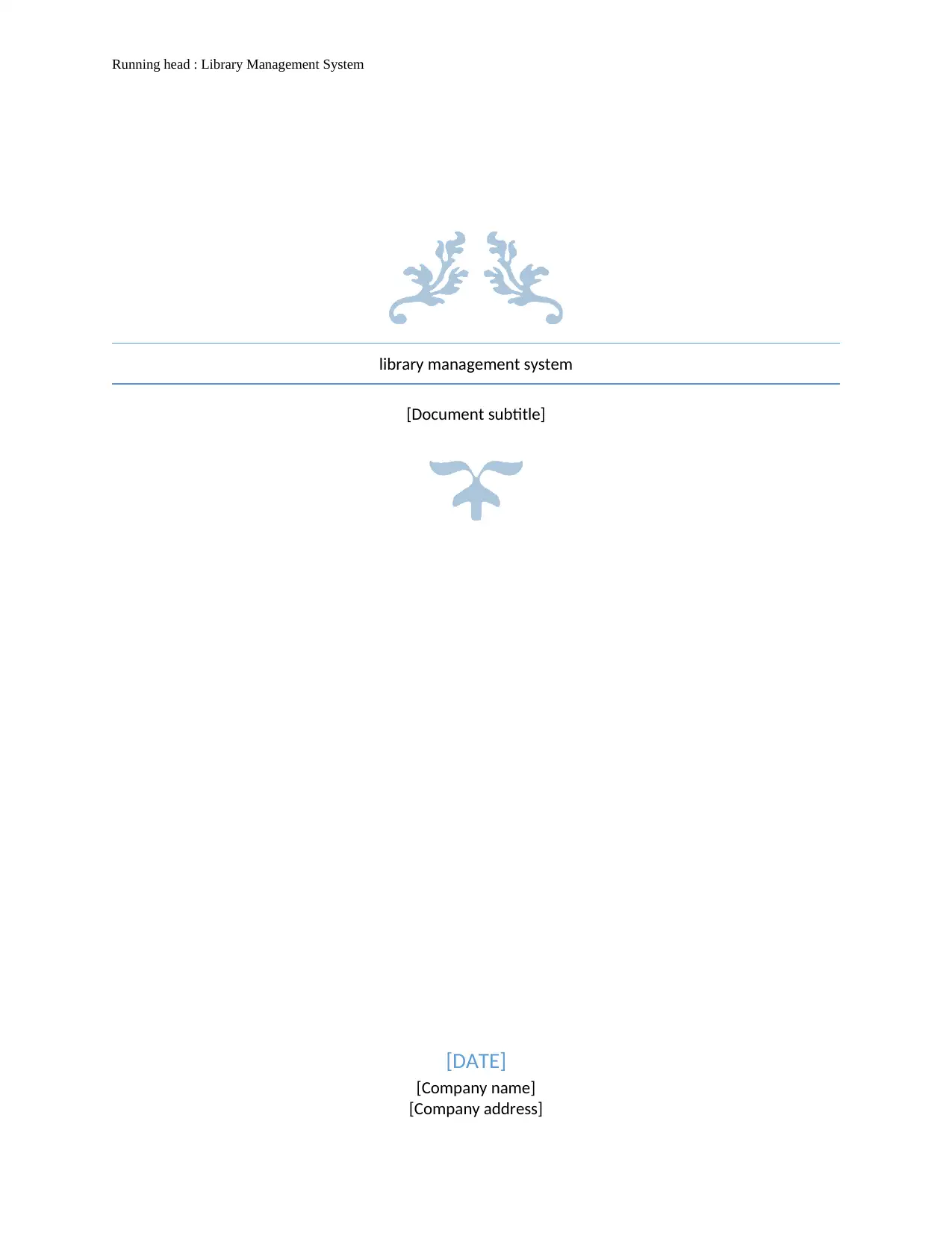
Running head : Library Management System
library management system
[Document subtitle]
[DATE]
[Company name]
[Company address]
library management system
[Document subtitle]
[DATE]
[Company name]
[Company address]
Paraphrase This Document
Need a fresh take? Get an instant paraphrase of this document with our AI Paraphraser
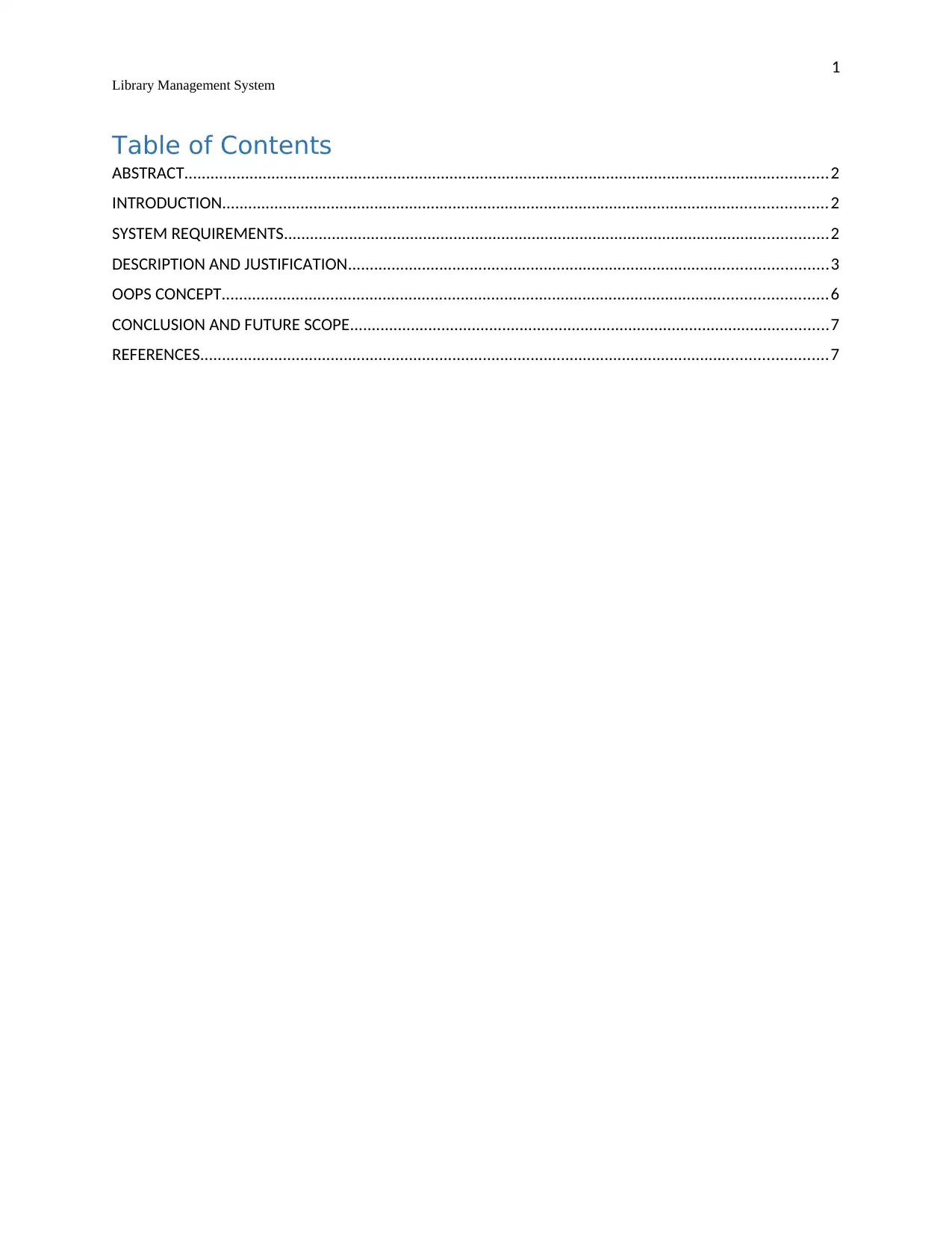
1
Library Management System
Table of Contents
ABSTRACT....................................................................................................................................................2
INTRODUCTION...........................................................................................................................................2
SYSTEM REQUIREMENTS.............................................................................................................................2
DESCRIPTION AND JUSTIFICATION..............................................................................................................3
OOPS CONCEPT...........................................................................................................................................6
CONCLUSION AND FUTURE SCOPE..............................................................................................................7
REFERENCES................................................................................................................................................7
Library Management System
Table of Contents
ABSTRACT....................................................................................................................................................2
INTRODUCTION...........................................................................................................................................2
SYSTEM REQUIREMENTS.............................................................................................................................2
DESCRIPTION AND JUSTIFICATION..............................................................................................................3
OOPS CONCEPT...........................................................................................................................................6
CONCLUSION AND FUTURE SCOPE..............................................................................................................7
REFERENCES................................................................................................................................................7
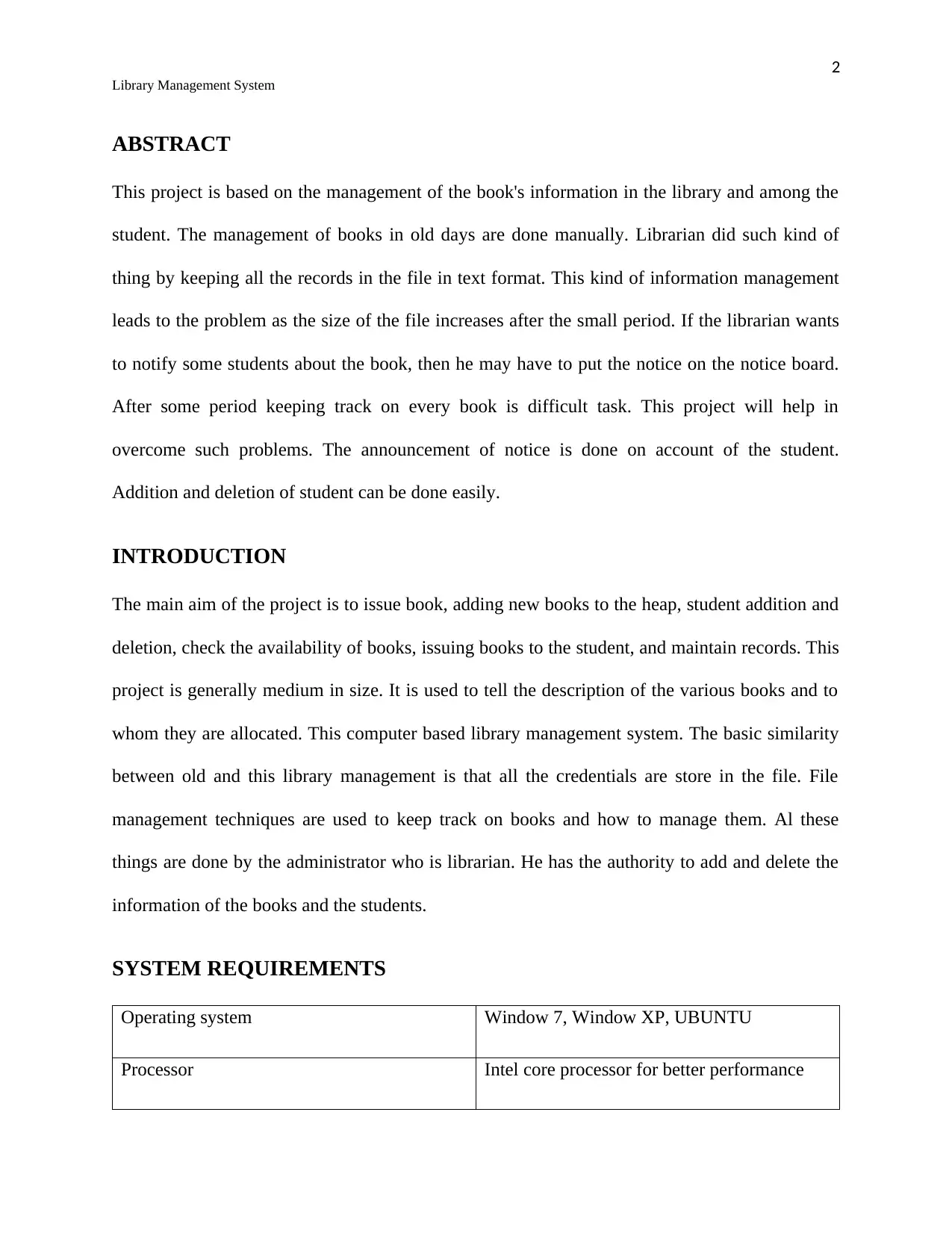
2
Library Management System
ABSTRACT
This project is based on the management of the book's information in the library and among the
student. The management of books in old days are done manually. Librarian did such kind of
thing by keeping all the records in the file in text format. This kind of information management
leads to the problem as the size of the file increases after the small period. If the librarian wants
to notify some students about the book, then he may have to put the notice on the notice board.
After some period keeping track on every book is difficult task. This project will help in
overcome such problems. The announcement of notice is done on account of the student.
Addition and deletion of student can be done easily.
INTRODUCTION
The main aim of the project is to issue book, adding new books to the heap, student addition and
deletion, check the availability of books, issuing books to the student, and maintain records. This
project is generally medium in size. It is used to tell the description of the various books and to
whom they are allocated. This computer based library management system. The basic similarity
between old and this library management is that all the credentials are store in the file. File
management techniques are used to keep track on books and how to manage them. Al these
things are done by the administrator who is librarian. He has the authority to add and delete the
information of the books and the students.
SYSTEM REQUIREMENTS
Operating system Window 7, Window XP, UBUNTU
Processor Intel core processor for better performance
Library Management System
ABSTRACT
This project is based on the management of the book's information in the library and among the
student. The management of books in old days are done manually. Librarian did such kind of
thing by keeping all the records in the file in text format. This kind of information management
leads to the problem as the size of the file increases after the small period. If the librarian wants
to notify some students about the book, then he may have to put the notice on the notice board.
After some period keeping track on every book is difficult task. This project will help in
overcome such problems. The announcement of notice is done on account of the student.
Addition and deletion of student can be done easily.
INTRODUCTION
The main aim of the project is to issue book, adding new books to the heap, student addition and
deletion, check the availability of books, issuing books to the student, and maintain records. This
project is generally medium in size. It is used to tell the description of the various books and to
whom they are allocated. This computer based library management system. The basic similarity
between old and this library management is that all the credentials are store in the file. File
management techniques are used to keep track on books and how to manage them. Al these
things are done by the administrator who is librarian. He has the authority to add and delete the
information of the books and the students.
SYSTEM REQUIREMENTS
Operating system Window 7, Window XP, UBUNTU
Processor Intel core processor for better performance
⊘ This is a preview!⊘
Do you want full access?
Subscribe today to unlock all pages.

Trusted by 1+ million students worldwide
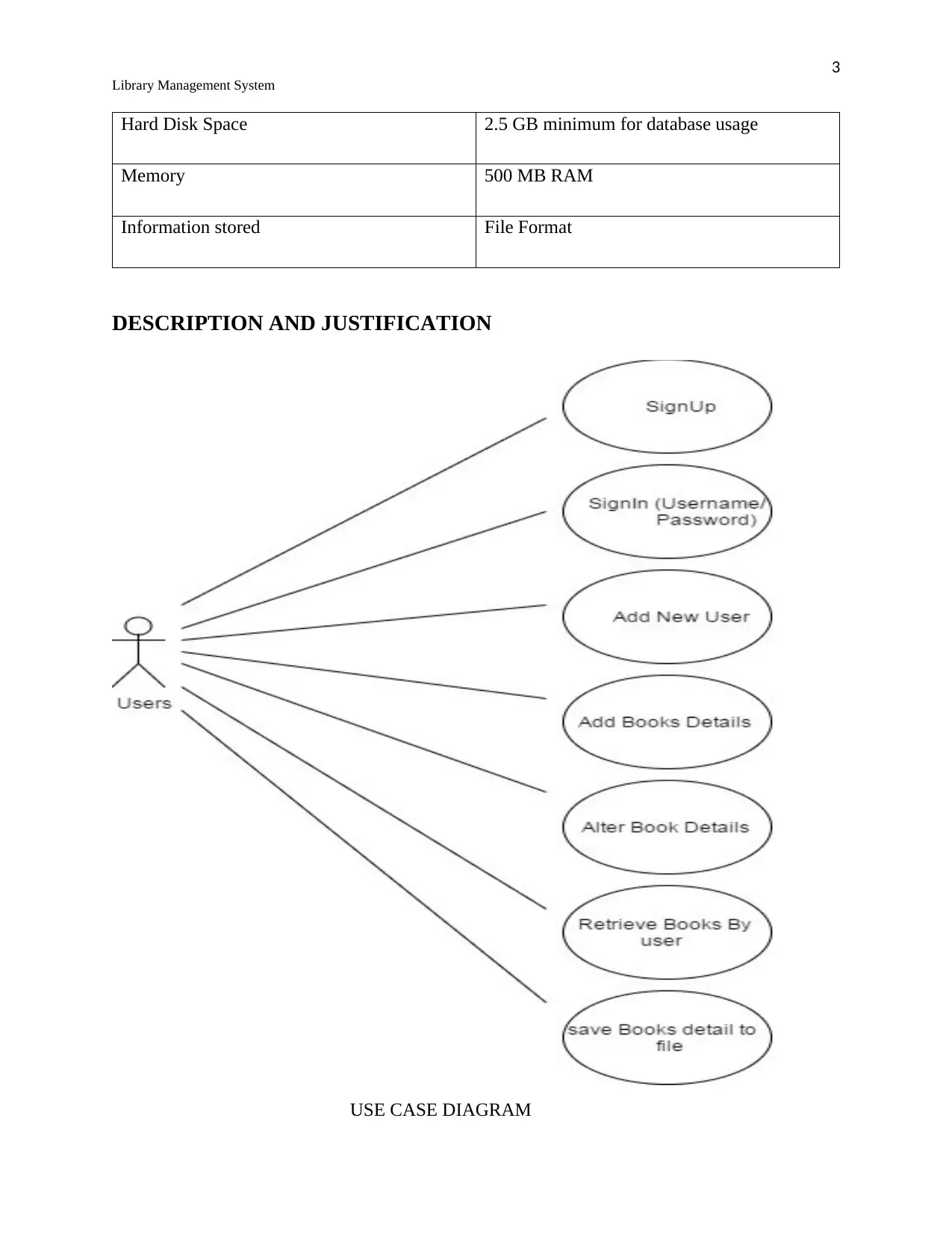
3
Library Management System
Hard Disk Space 2.5 GB minimum for database usage
Memory 500 MB RAM
Information stored File Format
DESCRIPTION AND JUSTIFICATION
USE CASE DIAGRAM
Library Management System
Hard Disk Space 2.5 GB minimum for database usage
Memory 500 MB RAM
Information stored File Format
DESCRIPTION AND JUSTIFICATION
USE CASE DIAGRAM
Paraphrase This Document
Need a fresh take? Get an instant paraphrase of this document with our AI Paraphraser
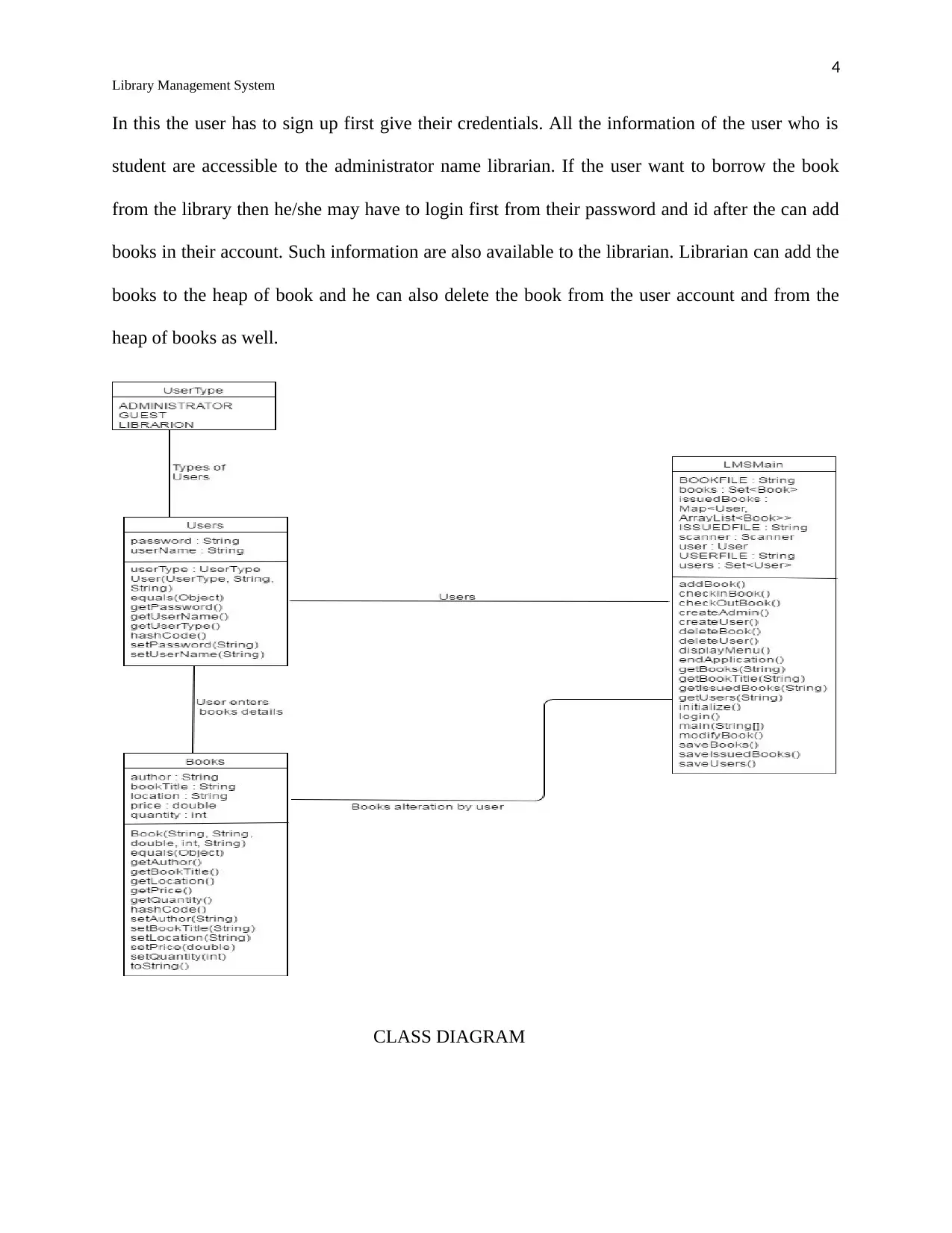
4
Library Management System
In this the user has to sign up first give their credentials. All the information of the user who is
student are accessible to the administrator name librarian. If the user want to borrow the book
from the library then he/she may have to login first from their password and id after the can add
books in their account. Such information are also available to the librarian. Librarian can add the
books to the heap of book and he can also delete the book from the user account and from the
heap of books as well.
CLASS DIAGRAM
Library Management System
In this the user has to sign up first give their credentials. All the information of the user who is
student are accessible to the administrator name librarian. If the user want to borrow the book
from the library then he/she may have to login first from their password and id after the can add
books in their account. Such information are also available to the librarian. Librarian can add the
books to the heap of book and he can also delete the book from the user account and from the
heap of books as well.
CLASS DIAGRAM
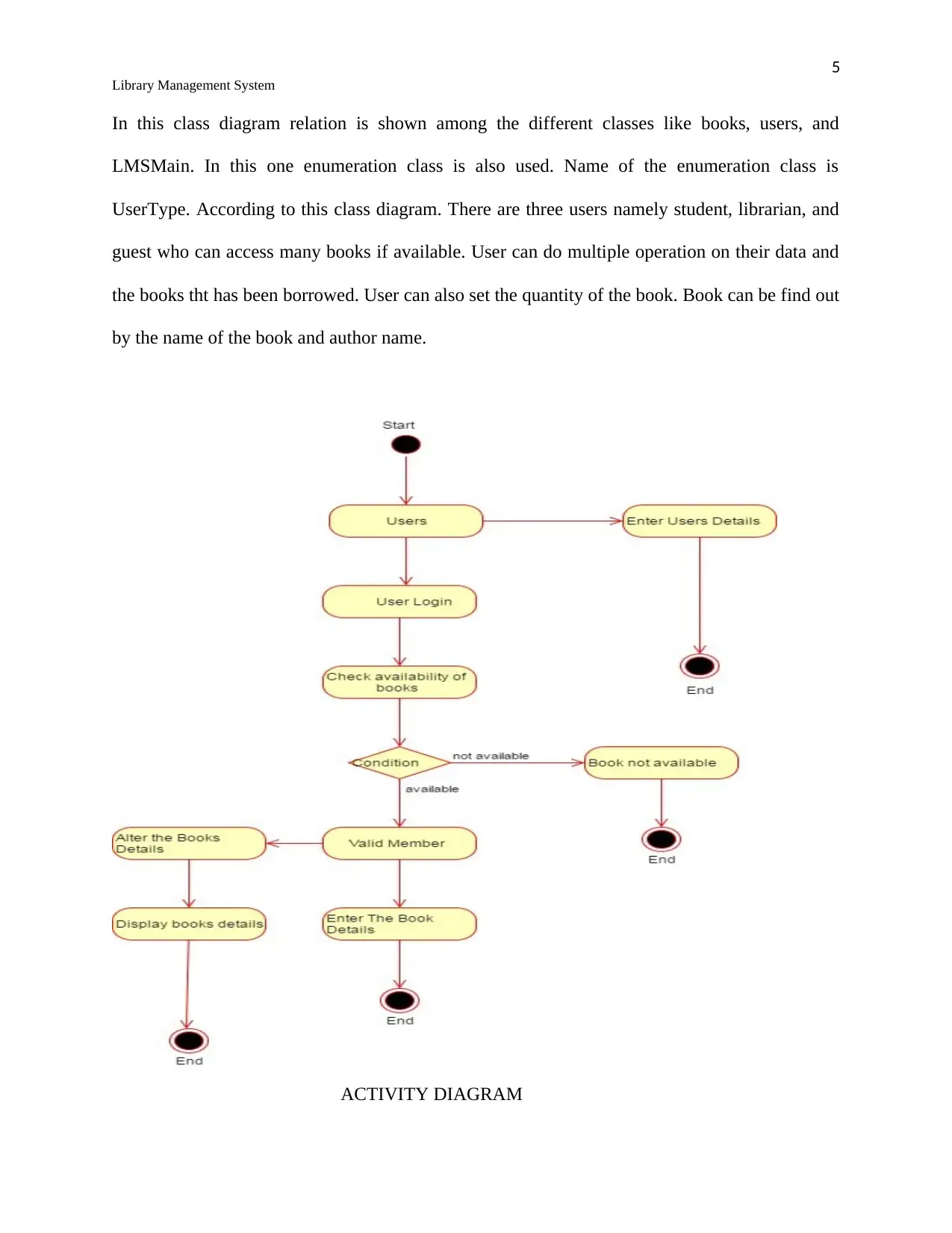
5
Library Management System
In this class diagram relation is shown among the different classes like books, users, and
LMSMain. In this one enumeration class is also used. Name of the enumeration class is
UserType. According to this class diagram. There are three users namely student, librarian, and
guest who can access many books if available. User can do multiple operation on their data and
the books tht has been borrowed. User can also set the quantity of the book. Book can be find out
by the name of the book and author name.
ACTIVITY DIAGRAM
Library Management System
In this class diagram relation is shown among the different classes like books, users, and
LMSMain. In this one enumeration class is also used. Name of the enumeration class is
UserType. According to this class diagram. There are three users namely student, librarian, and
guest who can access many books if available. User can do multiple operation on their data and
the books tht has been borrowed. User can also set the quantity of the book. Book can be find out
by the name of the book and author name.
ACTIVITY DIAGRAM
⊘ This is a preview!⊘
Do you want full access?
Subscribe today to unlock all pages.

Trusted by 1+ million students worldwide
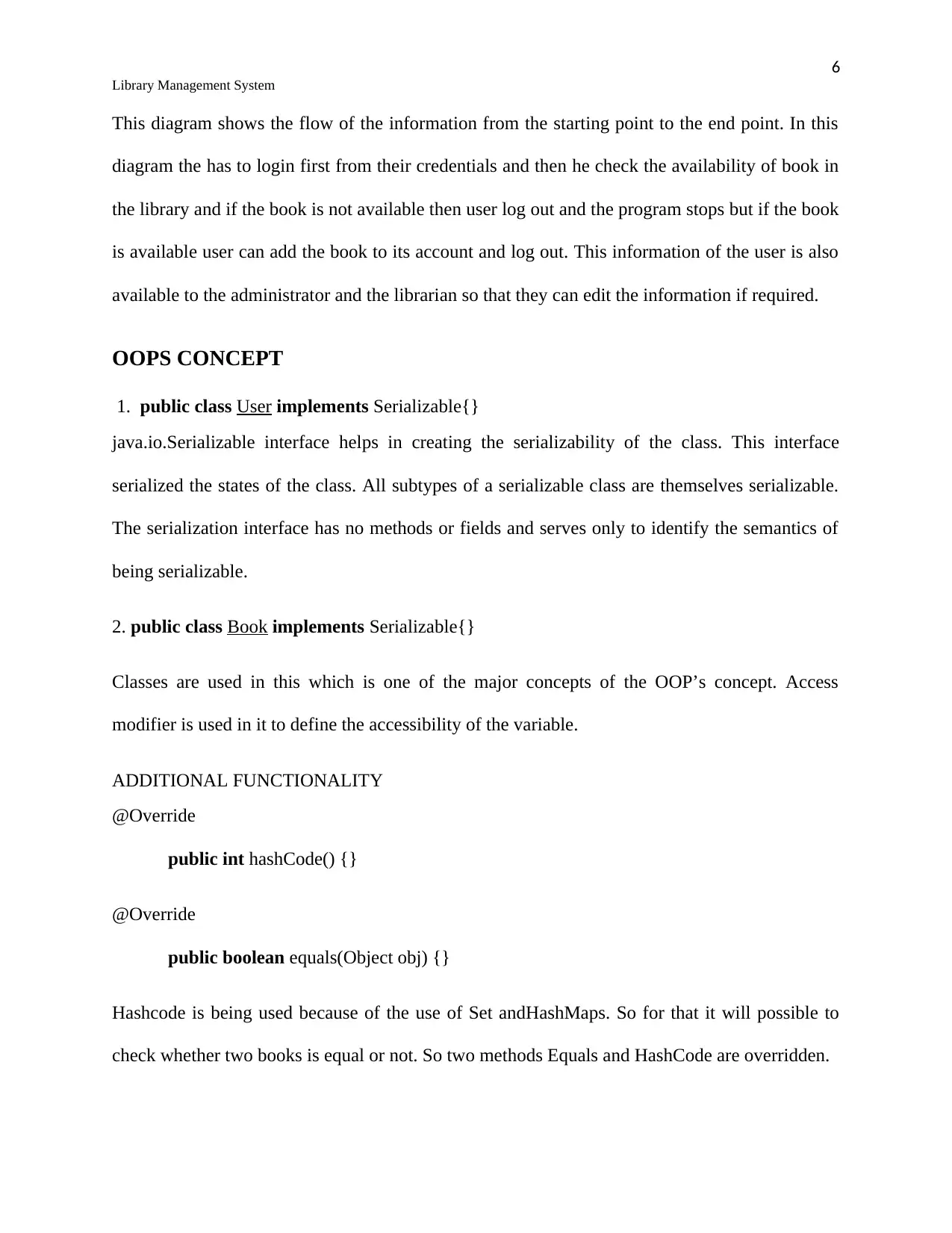
6
Library Management System
This diagram shows the flow of the information from the starting point to the end point. In this
diagram the has to login first from their credentials and then he check the availability of book in
the library and if the book is not available then user log out and the program stops but if the book
is available user can add the book to its account and log out. This information of the user is also
available to the administrator and the librarian so that they can edit the information if required.
OOPS CONCEPT
1. public class User implements Serializable{}
java.io.Serializable interface helps in creating the serializability of the class. This interface
serialized the states of the class. All subtypes of a serializable class are themselves serializable.
The serialization interface has no methods or fields and serves only to identify the semantics of
being serializable.
2. public class Book implements Serializable{}
Classes are used in this which is one of the major concepts of the OOP’s concept. Access
modifier is used in it to define the accessibility of the variable.
ADDITIONAL FUNCTIONALITY
@Override
public int hashCode() {}
@Override
public boolean equals(Object obj) {}
Hashcode is being used because of the use of Set andHashMaps. So for that it will possible to
check whether two books is equal or not. So two methods Equals and HashCode are overridden.
Library Management System
This diagram shows the flow of the information from the starting point to the end point. In this
diagram the has to login first from their credentials and then he check the availability of book in
the library and if the book is not available then user log out and the program stops but if the book
is available user can add the book to its account and log out. This information of the user is also
available to the administrator and the librarian so that they can edit the information if required.
OOPS CONCEPT
1. public class User implements Serializable{}
java.io.Serializable interface helps in creating the serializability of the class. This interface
serialized the states of the class. All subtypes of a serializable class are themselves serializable.
The serialization interface has no methods or fields and serves only to identify the semantics of
being serializable.
2. public class Book implements Serializable{}
Classes are used in this which is one of the major concepts of the OOP’s concept. Access
modifier is used in it to define the accessibility of the variable.
ADDITIONAL FUNCTIONALITY
@Override
public int hashCode() {}
@Override
public boolean equals(Object obj) {}
Hashcode is being used because of the use of Set andHashMaps. So for that it will possible to
check whether two books is equal or not. So two methods Equals and HashCode are overridden.
Paraphrase This Document
Need a fresh take? Get an instant paraphrase of this document with our AI Paraphraser
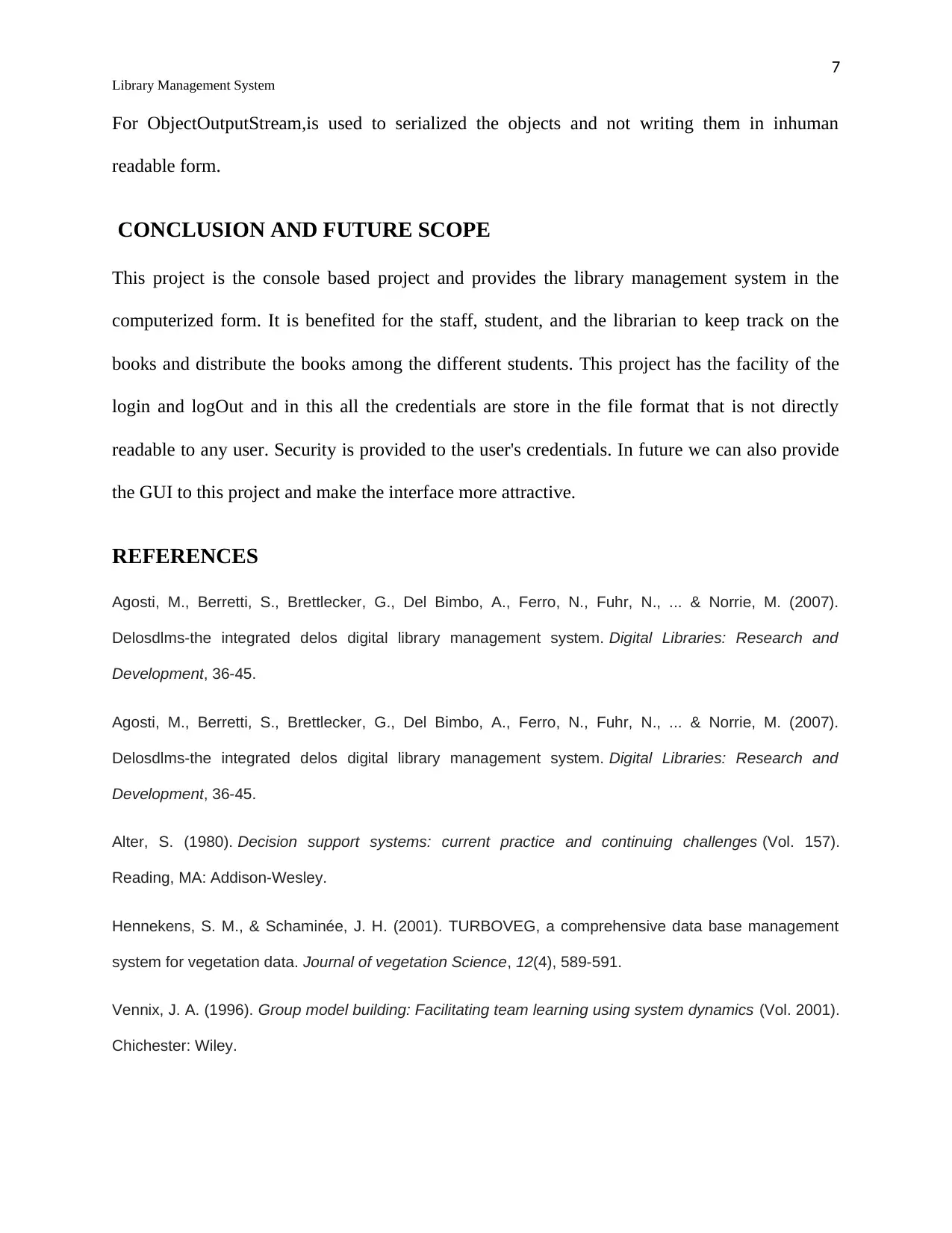
7
Library Management System
For ObjectOutputStream,is used to serialized the objects and not writing them in inhuman
readable form.
CONCLUSION AND FUTURE SCOPE
This project is the console based project and provides the library management system in the
computerized form. It is benefited for the staff, student, and the librarian to keep track on the
books and distribute the books among the different students. This project has the facility of the
login and logOut and in this all the credentials are store in the file format that is not directly
readable to any user. Security is provided to the user's credentials. In future we can also provide
the GUI to this project and make the interface more attractive.
REFERENCES
Agosti, M., Berretti, S., Brettlecker, G., Del Bimbo, A., Ferro, N., Fuhr, N., ... & Norrie, M. (2007).
Delosdlms-the integrated delos digital library management system. Digital Libraries: Research and
Development, 36-45.
Agosti, M., Berretti, S., Brettlecker, G., Del Bimbo, A., Ferro, N., Fuhr, N., ... & Norrie, M. (2007).
Delosdlms-the integrated delos digital library management system. Digital Libraries: Research and
Development, 36-45.
Alter, S. (1980). Decision support systems: current practice and continuing challenges (Vol. 157).
Reading, MA: Addison-Wesley.
Hennekens, S. M., & Schaminée, J. H. (2001). TURBOVEG, a comprehensive data base management
system for vegetation data. Journal of vegetation Science, 12(4), 589-591.
Vennix, J. A. (1996). Group model building: Facilitating team learning using system dynamics (Vol. 2001).
Chichester: Wiley.
Library Management System
For ObjectOutputStream,is used to serialized the objects and not writing them in inhuman
readable form.
CONCLUSION AND FUTURE SCOPE
This project is the console based project and provides the library management system in the
computerized form. It is benefited for the staff, student, and the librarian to keep track on the
books and distribute the books among the different students. This project has the facility of the
login and logOut and in this all the credentials are store in the file format that is not directly
readable to any user. Security is provided to the user's credentials. In future we can also provide
the GUI to this project and make the interface more attractive.
REFERENCES
Agosti, M., Berretti, S., Brettlecker, G., Del Bimbo, A., Ferro, N., Fuhr, N., ... & Norrie, M. (2007).
Delosdlms-the integrated delos digital library management system. Digital Libraries: Research and
Development, 36-45.
Agosti, M., Berretti, S., Brettlecker, G., Del Bimbo, A., Ferro, N., Fuhr, N., ... & Norrie, M. (2007).
Delosdlms-the integrated delos digital library management system. Digital Libraries: Research and
Development, 36-45.
Alter, S. (1980). Decision support systems: current practice and continuing challenges (Vol. 157).
Reading, MA: Addison-Wesley.
Hennekens, S. M., & Schaminée, J. H. (2001). TURBOVEG, a comprehensive data base management
system for vegetation data. Journal of vegetation Science, 12(4), 589-591.
Vennix, J. A. (1996). Group model building: Facilitating team learning using system dynamics (Vol. 2001).
Chichester: Wiley.
1 out of 8
Related Documents
Your All-in-One AI-Powered Toolkit for Academic Success.
+13062052269
info@desklib.com
Available 24*7 on WhatsApp / Email
![[object Object]](/_next/static/media/star-bottom.7253800d.svg)
Unlock your academic potential
Copyright © 2020–2025 A2Z Services. All Rights Reserved. Developed and managed by ZUCOL.


![UNI Library System Analysis: Project Report, [University Name]](/_next/image/?url=https%3A%2F%2Fdesklib.com%2Fmedia%2Fimages%2Fmb%2F488dc136f95047de91d331ef0b472565.jpg&w=256&q=75)

